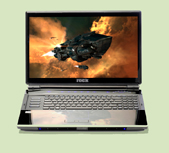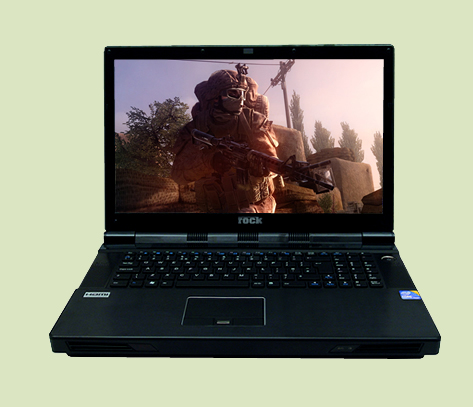Support / Jargon Buster S - U
A - C |
D - F |
G - I |
J - L |
M - O |
P - R |
S - U |
V - X |
Y - Z
SCSI: SMALL COMPUTER SYSTEM INTERFACE. This can support up to 8 devices (including the controller). Often used for hard drive, scanners, tape drive and CD-ROMs. The only way to have SCSI devices on a notebook is to buy a SCSI PCMCIA card. Adaptec are the most popular.
SDRAM: (Synchronous dynamic random access memory). This is a generic name for various kinds of DRAM that are synchronized with the clock speed that the microprocessor is optimised for. This tends to increase the number of instructions that the processor can perform in a given time. The speed of SDRAM is rated in MHz.
SECTOR: This is the smallest storage unit allocated on a hard drive.
SEEK TIME: the average time it takes for a hard drive to position its heads to a specific area. The shorter, the better.
SERIAL PORT: This is a connection for a serial device like a mouse or a modem. On a PC, this socket is a 9 pin male connector at the back of the notebook. They work with a single data line-sending data one bit at a time. Also known as a COM (Communication) port.
SGRAM: (Synchronous Graphics RAM). This is clock-synchronized RAM that is used for video memory. It is relatively low-cost video memory. It uses masked write, which enables selected data to be modified in a single operation rather as a sequence of read, update, and write operations. It also uses block write, which allows data for background or foreground image fills to be handled more efficiently. SGRAM is single-ported. Its special features are what make it a moderately fast form of video memory.
Shareware: Shareware software is distributed free, usually via the Internet. You can use it for evaluation purposes, but are trusted to send money to the authors if you want to use it regularly. Sometimes sending a payment brings a more powerful version of the software, together with access to technical support and future upgrades. For small software firms, shareware can provide access to markets without the need to invest heavily in marketing and distribution.
Spam: Unsolicited email advertising which targets many recipients simultaneously.
SSL (Secure Socket Layers): Netscape's de facto standard for encrypting TCP/IP applications, but used mainly for encrypting communications over the web.
SURROUND SOUND: It is known as 3D Sound as well. Stereo sound is standard and uses two speakers. 3D sound attempts to create a full sound stage, including noises from the rear, using just two speakers. It works best with headphones, so is an ideal extra for a portable.
SVGA: SUPER VIDEO GRAPHICS ARRAY. This is an enhanced version of VGA. Unlike VGA, SVGA tends to be proprietary, with exact specifications varying from manufacturer to manufacturer. While a VGA display driver would generally work with any video card, SVGA drivers are specific to a particular video card. SVGA offers higher resolutions and greater colour depths than VGA. It is capable of doing resolutions of 1600 by 1200, depending if the monitor and video card are capable of going this high. They can also go up to 32-bit colour (16.7 million colours).
TCP/IP: This is the most widely used routeable network protocol, also the protocol which is used by the Internet.
Telnet: An application allowing remote login between computers located anywhere on the Internet.
TFT: Thin Film Transistor, a superior type of LCD screen also referred to as ‘active matrix display’. In this type of display its own transistor, which results in higher resolution, controls each of the screen’s pixels and contrast and an improved vertical refresh rate.
TRACKPAD/POINT: A pointing device that allows you to move the mouse pointer by sliding a finger around on a touch-sensitive surface. To click tap your finger on the surface or press a button.
TRUE COLOR: video cards that can show 24-bit colour (up to 16.7 million colours). Video cards with 1 MB of memory can handle true colour.
TSR: TERMINATE STAY RESIDENT. This is a program which when loaded stays in memory and remains active but returns control of the PC back to the user. Anti-virus packages tend to include a virus guard program which remains in memory looking for virus infection, this program is a TSR.
UDMA: ULTRA DIRECT MEMORY ACCESS. This is a new standard replacing the EIDE of hard drives. The main reason for this is that it allows data to be transferred at much faster speeds. In order to use UDMA, you need to have a hard drive, hard drive controller and operating system, all capable of using UDMA.
UPS (Uninterruptible Power Supply): A system which allows computers to keep running for a limited time during a power failure. It gives you the chance to save data before your system crashes.
URL (uniform resource locator): is the address of a file accessible on the Internet, such as a website address. The unique identification of a web site or web resource, such as http://www.scottish-enterprise.com
USB: UNIVERSAL SERIAL BUS. A system of connecting up to 127 different peripherals (printers, modems, joysticks) to a computer using a single type of connector. Developed by a consortium including Intel and Microsoft, USB allows for ‘hot’ insertion of peripherals – i.e. without powering down the system.
|


 Xtreme
Xtreme









